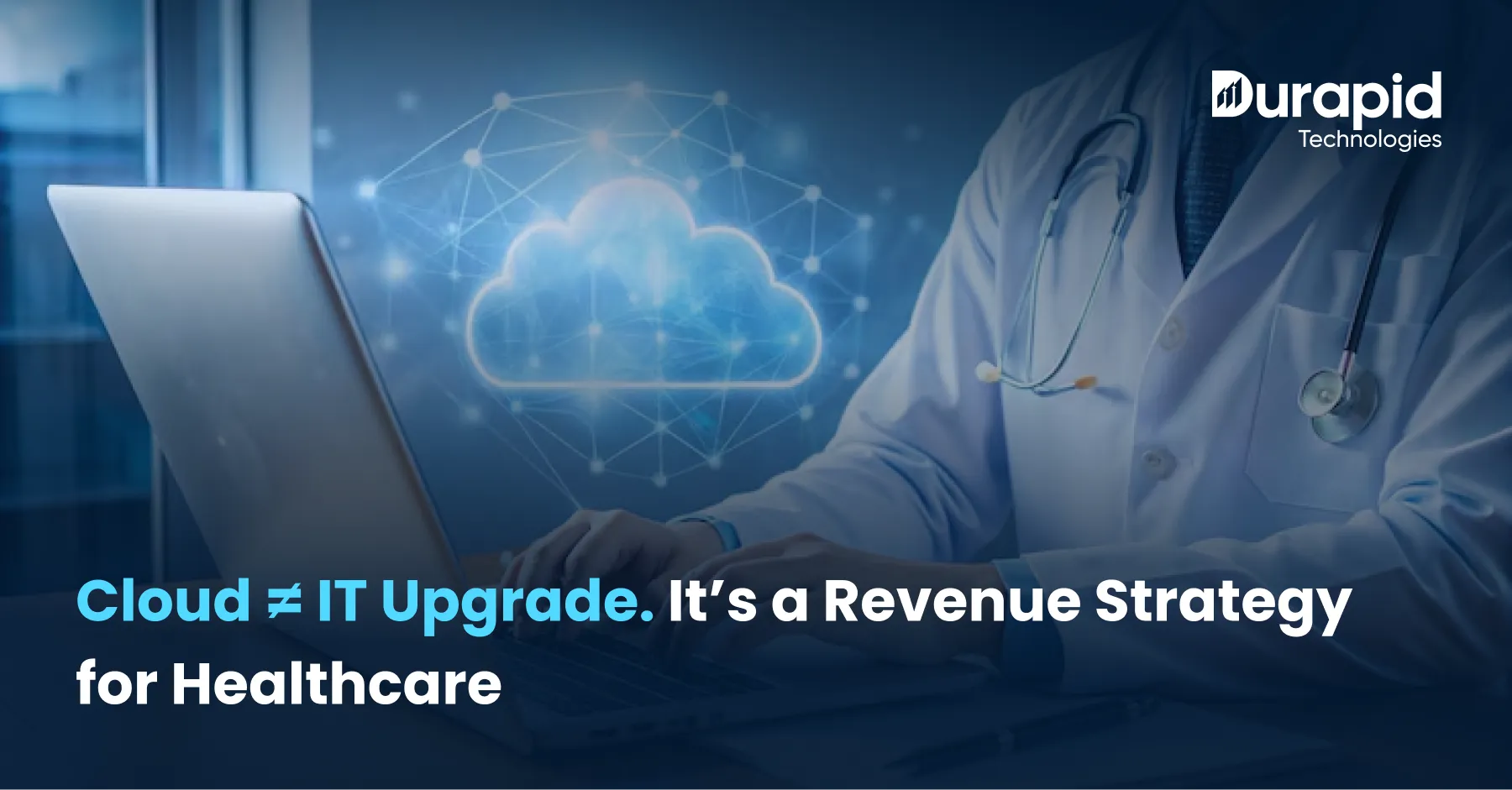Cloud ≠ IT Upgrade. It’s a Revenue Strategy for Healthcare

Why Cloud Isn’t Just Tech, It’s Revenue Thinking
For years, the cloud was treated like a background upgrade, a new home for data, a faster server, or an easier backup solution. But for modern healthcare providers, cloud modernization has become much more than that.
It is now a core revenue strategy, deeply tied to:
- Billing performance
- Patient experience
- Workflow efficiency
- Speed of innovation
- Data-driven service delivery
Whether you’re a hospital system, diagnostic chain, or digital-first clinic, your healthcare cloud decisions directly impact how much value you create and capture. At Durapid, we’ve seen firsthand how strategic cloud adoption transforms healthcare revenue models.
Gone are the days of viewing the cloud as just “IT infrastructure.”
Today, it’s a growth engine.
The Real Problem: Legacy Systems Drain Revenue and Block Innovation
Before we talk about transformation, let’s talk about what needs transforming.
Legacy healthcare IT systems, often decades old, were never built for today’s data volume, compliance complexity, or patient expectations. The impact?
Revenue Risks from Legacy Infrastructure:

- Billing Delays and Errors: Paper-based workflows and outdated RCM tools increase denials, delays, and underpayments.
- Limited Patient Engagement: No-shows and attrition go up when scheduling or teleconsultation is hard.
- Inaccessible Insights: Clinical, operational, and financial data sit in silos.
- High IT Overhead: Maintaining outdated systems eats up capital with low ROI.
- Compliance and Security Risks: Legacy systems lack real-time monitoring or modern encryption, opening doors to breaches.
And let’s be clear: when data is stuck and systems don’t talk, revenue is always left on the table.
This is where cloud based healthcare solutions become game-changers.
Reframing the Cloud: From Backend Shift to Frontline Strategy
What if the cloud wasn’t just where your tech lived but where your revenue strategy evolved?
With cloud modernization, healthcare organizations can now:
- Deliver care faster
- Streamline backend operations
- Automate repetitive workflows
- Scale services across geographies
- Launch new, high-margin offerings (like SaaS or remote diagnostics)
That’s not backend optimization.
That’s a frontline transformation.
A 2023 McKinsey report shows healthcare systems can capture 20-30% cost and revenue improvement through cloud-driven transformation when paired with operational redesign.
So instead of asking, “Should we migrate to the cloud?”, the better question is:
“How will the cloud help us capture more value across the care journey?”
Cloud Modernization in Healthcare: What It Really Involves
Let’s unpack what cloud modernization in healthcare looks like technically and strategically.
Key Technical Shifts:
- Cloud-native architecture using microservices and containers
- APIs and FHIR standards for interoperability
- Unified data lakes for structured and unstructured data
- Integrated analytics engines to power reporting and care decisions
- Identity & Access Management (IAM) for compliant access control
Key Strategic Shifts:
- Moving from capital expenditure (CapEx) to operating models (OpEx)
- Replacing fixed infrastructure with scalable, pay-as-you-grow environments
- Focusing on outcomes, not just uptime
- Shifting tech from cost center to revenue enabler
This is why healthcare IT modernization isn’t about just swapping systems.
It’s about rethinking the foundation of your business model.
Technical Foundations of a Revenue-Readycloud
Let’s get one thing straight: moving to the cloud isn’t just about shifting servers. It’s about building smarter systems that actually move the needle on revenue, experience, and long-term growth.
Our cloud modernization services help healthcare organizations implement these exact strategies.
1. Infrastructure That Expands as You Grow
At the base of every strong healthcare cloud strategy is infrastructure that knows how to breathe, stretching when needed, and shrinking when not.
What the best are doing:

- Auto-scaling compute power
Think of it like a heartbeat. Use tools like AWS EC2 Auto Scaling or Azure VM Scale Sets to automatically match resources to demand.
When patient load spikes, your systems flex. When it’s calm, you save on costs. - Microservices, not monoliths
Instead of one giant block of software, modern systems break into independent services, deployed using Kubernetes (EKS/AKS).
Your billing module can update without affecting the EMR. Your patient portal can scale separately from your internal dashboard. It’s modular, fast, and resilient. - Hybrid cloud with security in mind
Use Direct Connect or ExpressRoute to create secure tunnels between on-prem and cloud. This hybrid model lets you keep critical data local while scaling other parts of the system with cloud agility. - Designed for continuity
Redundancy across regions, auto-failover, and disaster recovery are part of the foundation. Not the afterthought.
Bottom line: Infrastructure isn’t just tech, it’s your uptime, patient trust, and ability to deliver care when it matters most.
2. Data That Actually Works for You
Modern healthcare runs on data. But messy, fragmented, and delayed data? That’s a liability.
Here’s what next-gen setups look like:
- Lakehouse architecture
Instead of siloed databases, systems now combine the flexibility of data lakes with the structure of warehouses. Tools like Delta Lake or Databricks let teams run analytics in real-time, without cleaning for days. - Storage with built-in compliance
Patient records are stored in Amazon S3 or Azure Data Lake, fully encrypted and access-controlled.
You meet HIPAA standards by default, not by extra paperwork. - ETL without the headaches
Whether it’s AWS Glue, Azure Data Factory, or Informatica, modern data pipelines handle the grunt work of pulling from EHRs, billing systems, and wearable devices, and turning that into usable dashboards. - Smart data governance
Tagging, cataloging, versioning, it’s all built-in. Meaning every data point is traceable, trustworthy, and ready to serve your analysts or AI tools.
The real win: You stop drowning in data and start using it to deliver faster decisions, smarter care, and better revenue visibility.
3. Applications That Talk to Each Other and to Your People
It’s not enough to have powerful systems. They need to speak the same language. And most importantly, they need to serve people, not slow them down.
Here’s how smart teams are building their app layer:
- Open APIs using healthcare standards
Whether it’s FHIR, HL7, or X12, exposing APIs through API Gateway ensures your systems are interoperable.
This means your EHR can pull from labs, update billing, and sync with insurers, without manual work. - Micro-frontends for flexible UX
Imagine your patient portal or admin dashboard built with React-based micro-frontends.
Each part- billing, appointments, and feedback can evolve independently. You fix one bug without breaking the whole house. - Workflow automation that just works
With Azure Logic Apps or AWS Step Functions, internal processes become orchestrated.
From intake to discharge, you reduce manual handoffs, speed up tasks, and reduce revenue leakage. - Low-code tools for the win
Want to build a new internal tool without waiting 6 months for dev cycles? Low-code platforms like PowerApps let your team ship ideas faster and safely.
Why it matters: When your systems talk to each other and your users, they don’t just work better. They work together to drive revenue and satisfaction.
4. Security That’s Built In, Not Bolted On
Let’s be honest, security conversations used to feel like blockers. Now, they’re table stakes for any serious healthcare system. Patients care. Regulators care. You should too.
What real cloud security looks like today:
- Access control and full visibility
With Role-Based Access Control (RBAC), multi-factor authentication, and audit logs, you know exactly who touched what and when. - Patient data is protected at every step
Encryption is automatic both in transit and at rest. You can also use tokenization or anonymization when running analytics or training ML models. - Always-on compliance monitoring
Tools like AWS Config or Azure Security Center continuously check if your infrastructure is still within HIPAA or GDPR compliance.
No more scrambling at audit time. - Zero Trust done right
Instead of trusting anything by default, Zero Trust architecture limits access at every level of the network, user, and service.
The NIST Cybersecurity Framework provides comprehensive guidance for implementing Zero Trust in healthcare environments.
What you get: Peace of mind, fewer breaches, and a system you can explain (confidently) to both your CTO and your legal team. Discover how our healthcare security framework ensures HIPAA compliance from day one.
5. Visibility and Control Over What Matters
If you can’t see it, you can’t fix it. And if you can’t control it, you can’t scale it. That’s why monitoring and cost optimization are central, not optional.
How teams are staying in control:
- Full-stack observability
Use Prometheus, Grafana, CloudWatch, or Azure Monitor to track performance from infrastructure to app to user behavior.
You’ll know when a system is slowing down before a doctor ever notices. - Cost optimization with FinOps tools
Keep tabs on every dollar using AWS Cost Explorer, Azure Advisor, or tools like CloudHealth.
Tag workloads set budgets, kill zombie services. Stay lean, stay smart. - Reliable by design
Disaster recovery is not a Plan B; it’s built into your Plan A. Multi-region backups, auto-failover, and zero-downtime deployments make sure your revenue and care delivery stay uninterrupted. - Predictive alerts, not reactive chaos
With ML-powered tools like DevOps Guru or Azure Monitor Insights, you get early warnings, before a billing failure or data sync delay costs you money.
The difference: You don’t just use cloud resources. You own them, with data to prove it.
Pulling It All Together
When you build your tech on this kind of foundation, it doesn’t just run better, it works harder for you.
- Your infrastructure scales with demand (and doesn’t eat your budget).
- Your data becomes a source of truth, not frustration.
- Your applications serve your people, not the other way around.
- Your security is automatic, compliant, and trustworthy.
- Your monitoring gives you the clarity to improve margins and respond fast.
This is what cloud modernization looks like when it’s done right. Not just a move to new servers, but a move toward smarter revenue, faster decisions, and stronger patient outcomes.
And yes, this is where healthcare is headed.
How Cloud Directly Impacts Revenue Streams
Here’s how cloud modernization translates into tangible revenue gains for healthcare:
1. Accelerated Revenue Cycle Management (RCM)
- Automate claims filing, eligibility checks, and follow-ups
- Cut revenue cycle time from 30+ days to under a week
- Reduce claim denials with real-time data validation
2. Remote Health Services
- Launch scalable telehealth modules and virtual triage
- Add high-margin remote monitoring packages
- Improve appointment rates and reduce patient churn
3. New Business Models via SaaS
- Package internal tools (like patient CRM or billing engines) into SaaS for other clinics
- Multi-tenant, HIPAA-ready architecture supports scalable monetization
4. Predictive Care Planning
- Use AI to predict readmissions, patient attrition, and capacity bottlenecks
- Drive proactive interventions that improve care and cut unplanned costs
5. Intelligent Supply Chains
- Track real-time usage, automate reorders
- Prevent overstocking or shortages
- Cut procurement waste and align stock with actual clinical demand
The benefits of cloud transformation for healthcare providers go far beyond backend efficiencies. They’re building flexible, revenue-creating digital ecosystems.
The Role of Culture: Why Modernization Needs Mindset Shifts
Tech alone doesn’t transform revenue. People do.
To realize the full impact of cloud computing in healthcare, organizations need cultural transformation:
- From IT-first to patient-first thinking
- From long-cycle planning to agile experimentation
- From silos to shared KPIs across business, tech, and care teams
Key Internal Shifts to Support Cloud Revenue Strategy:
- Cross-functional cloud centers of excellence (COEs)
- Cloud-certified upskilling for engineers and operations
- Outcome-based measurement: patient satisfaction, claims velocity, tech ROI
- Integrated DevOps and FinOps for velocity and visibility
If your teams don’t adapt to the tech, the revenue won’t follow.
FAQs:
Q1: How does cloud modernization boost healthcare revenue?
- By reducing manual billing effort and claim errors
- Launching virtual care offerings that scale without adding headcount
- Enabling predictive analytics that cut readmission costs
- Opening doors for monetizing internal tools as SaaS
Q2: What are the benefits of cloud transformation for healthcare providers?
- Faster access to data, enabling quicker decisions
- Cost savings from optimized IT operations
- Improved security posture with built-in compliance
- More innovative patient experiences and outreach models
Q3: How to implement cloud strategy in healthcare organizations?
- Start with a workload assessment
- Pilot modernization in low-risk, high-impact areas like RCM or scheduling
- Partner with cloud-native vendors who know the healthcare
- Build cloud governance and compliance from day one
Conclusion: Cloud Modernization Is a Revenue Mindset
Still, seeing the cloud as just an IT task? You’re leaving revenue on the table.
The right cloud strategy means faster billing, smoother care, scalable services, and yes, real growth.
At Durapid, we help healthcare teams turn cloud modernization into a revenue mindset.
Let’s build systems that don’t just work, but perform.





